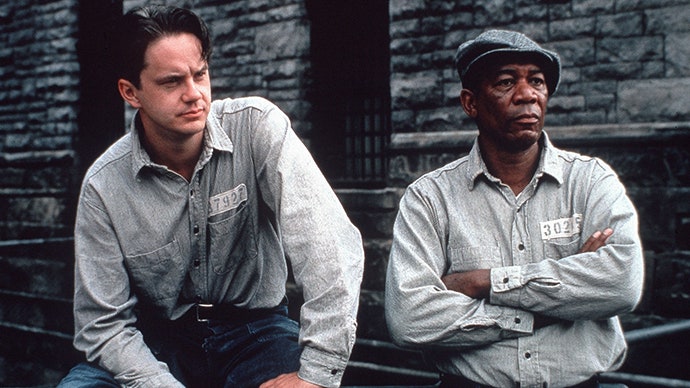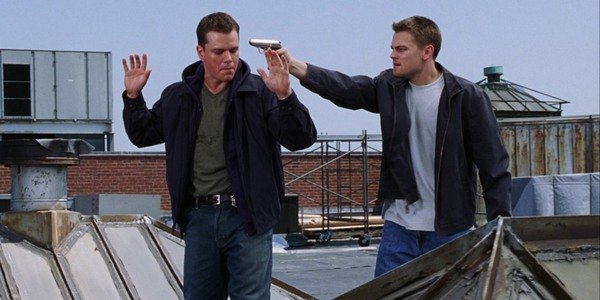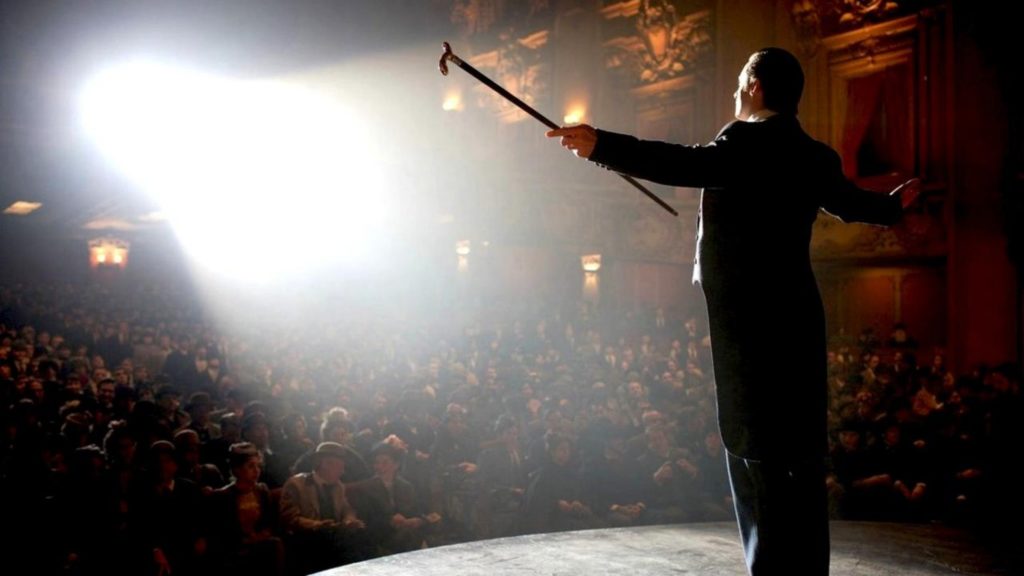How to Write When You Have More Then Pne Protagonist
Table of Contents
- Dual Protagonists: Breaking the Mould
- The Function of a Protagonist
- Empathy for Your Protagonist
- The Dual Protagonists
- The Three Plot Lines
- Competing for a Shared Goal
- The Departed
- The Inner + Outer Journeys
- The Shawshank Redemption
- A Unifying Theme
- Challenging Their Beliefs
- The Prestige
- Robert Angier and Alfred Borden
- The Structure of Dual Protagonists
- Tandem Narratives
- Flashback Forms
- In Summary
Dual Protagonists: Breaking the Mould
There is no law in screenwriting that dictates you must only have one protagonist, or main character, in your screenplay. Granted, most writers choose to dedicate their limited number of pages to focus on one particular character's story. After all, it is difficult enough to design one credible character journey, let alone a dual protagonist story.
The protagonist is the character that should occupy most of the screen time and undergo the most amount of change. Therefore, the obvious solution to writing a story with dual protagonists is to make sure your two characters have equal amounts of screen time and both experience a significant arc. Alas, that is not enough.
Dual protagonists must equally spiral, intersect and clash multiple times throughout the course of your screenplay. Their journeys on both a plot and thematic level have to be closely intertwined. You also need a structure that is specially designed to handle dual protagonists and a story that ultimately warrants the inclusion of this tricky device.
If you are willing to risk breaking the mould and expand your story over two central characters, then there are several mistakes and potholes that must be avoided at all costs.
The Function of a Protagonist
You actually see examples of dual protagonists in cinema a lot less than you might think. What appears to be dual protagonists on the surface, is actually just one protagonist with a very good, very necessary secondary character. In order to make sure you stay clear of writing this character dynamic by mistake, you first need to understand the function of the protagonist in your story.
A protagonist is the character who drives the story forward and is therefore the central focus of your screenplay.
The simplest and most iconic example of a protagonist is the "hero". They are the brave and idealistic characters that work for the greater good. However, not all central characters have to be virtuous shining examples of moral decency.
Even though protagonists can occasionally be seen to break rules, ultimately, their intentions are for good. Good intentions might be hard to find with certain characters. Although, a great protagonist will always make us see their side.
Creating a protagonist with a one-dimensional collection of moral, likeable and boring character traits doesn't always equate to support from the audience. To quote Robert McKee…
"Likeability is no guarantee of audience involvement; it is merely an aspect of characterization".
To put the audience into the perspective of your protagonist, you must be able to create empathy for the character.
Empathy for Your Protagonist

Empathy is the glue that holds together an audience's emotional involvement with your character. It is the ability to understand and share the feelings of another.
So how do you create empathy for your protagonist? How do you make sure they are the ones driving the plot forward instead of a secondary character?
- We follow that character's pursuit of a specific goal.
We empathise with a character when we have a clear understanding of what they want to gain during the story and the motivations behinds their actions to achieving this. Despite whether we agree with the choices or not, we know why the character has made them.
Whether the character's goal is achieved or not, it is less important than the journey itself. A protagonist that overcomes failure is far more compelling than one that gets the easy win. The more they struggle to achieve their goal, the more we will want to see them succeed.
- We witness that character having the most significant growth.
A great protagonist must also have a strong character arc. They must learn something from their journey, be it about themselves, others or life.
This change to their inner thoughts and feelings allows the audience to empathise with the protagonist, having witnessed their emotional growth. If they haven't grown by the end of the story, the lack of development will drive an audience mad.
The protagonist is the character who changes the most and they are not the protagonist at all if they don't change.
The Dual Protagonists
There are two methods to crafting dual protagonists in screenwriting. They are co-protagonists and parallel protagonists.
'Co-protagonists'
- This consists of two characters who both want the same thing and are both struggling towards the same goal.
- In this method, you have to contrast these characters so they don't react to conflict in equal ways.
- They need to have two very different personalities, which in turn helps highlight the flaws in both of the characters.
'Parallel protagonists'
- This is arguably the more difficult of the two methods to pull off.
- This structure consists of two characters in separate stories, each with their own individual goals.
- The two character journeys cut back and forth from one another, working together by counterpointing each other.
One story's success and another story's failure is then mirrored. They go back and forth, commenting on one another, running parallel until they eventually meet at the climax.
This method requires a shifting focus in the overall story, as the audience's perspective has to switch between the characters. Each protagonist pursues their own goal, complete with introductions, plot progressions, setbacks and resolutions. However, these two separate stories must thematically reflect one another, contrasting themselves around the same fundamental idea of the theme.
We will be using these three films as case studies…
- Andy Dufresne and Ellis Boyd 'Red' Redding (The Shawshank Redemption).
- Collin Sullivan and Billy Costigan (The Departed).
- Robert Angier and Alfred Borden (The Prestige)
Through them, we will examine both of these dual protagonist methods in depth and highlight the various setbacks and challenges a writer might endure when tackling this story device.

The Three Plot Lines
The first major mistake facing screenwriters of a dual protagonist story is that one of the central characters loses interest halfway through the screenplay. At some point down the line, the writer will steer the focus away from one protagonist and consequently, the audience's engagement will soon follow suit.
We see one of the protagonists drop the ball and no longer aggressively pursue their goal. This can be the result of a variety of reasons.
- Lack of conflict between the characters.
- Disproportionally greater stakes in the (remaining) main character's goal.
- The two characters' stories don't spiral, intersect and clash multiple times.
Since the dual protagonists are often seen separated throughout the story, interacting with other characters, there has to be something that both protagonists equally want.
- This want will cause them to journey either towards or apart from each other along their individual plot lines.
- The solution is that you need to create a third plotline.
- The protagonists must pursue their own individual desires whilst also competing for a shared plot goal.
Competing for a Shared Goal
Essentially, this makes each of the protagonists the other's antagonist, as they're in direct opposition to one another's main goal. To quote John Truby…
"It is only by competing for the same goal that the hero and the opponent are forced to come into direct conflict and to do so again and again throughout the story".
Therefore, as we switch perspective from protagonist to protagonist in their clashing journeys towards this unifying goal, we're asked to root for one character in one scene and in the very next scene asked to root for the other character.
- This is how you mirror success in one protagonist's story by success or failure in the other protagonist's story.
- You lose the thread of one character's point of view on a situation (and their goal) whilst you're with the other character reacting to what they have done, making them the one the audience is now connected with.
- We want both characters to achieve this goal but that cannot happen, so we veer back and forth, in terms of whose side we're on in the moment.
- Now your audience is engaged and they're invested in the outcome of both your protagonists' stories.
The Departed

The departed is a perfect example of a dual protagonist story where the characters run parallel to one another. Both the characters of Collin and Billy are created with their own individual goals whilst sharing an overall plot goal that unifies their stories. They are both searching for the "rat".
The goal comes with its own set of serious stakes equally proportional to the two characters.
- If Collin is discovered as the mob's inside man in the police, he will be sent to prison.
- If Billy is discovered as an undercover officer inside the mob, he will be killed.
The pursuit of this competing goal plays out in a cat and mouse chase throughout the screenplay. The two characters' separate stories continuously move back and forth commenting on each other.
The mirroring of success and failure is highlighted in a particular sequence were Collin sends the mob to a warehouse where Billy and his captain are meeting.
- The captain is killed and therefore Billy loses his only connection inside the police force.
- Consequently, due to the captain's death, Collin is promoted and now has access to all the undercover files.
Failure for one protagonist amounts to success for the other protagonist and this all stems from them being in direct conflict competing for the same goal.
The Departed (2005) Official Trailer - Matt Damon, Jack Nicholson Movie HD
The Inner + Outer Journeys
The second of the major hurdles in writing a dual protagonist story comes in the form of only one main character having a clear journey. When two characters share equal screen time but only one carries the story forward, the other will soon feel flat and simply just an annoying add-on to the story.
It is difficult to write two distinct central characters who keep their appeal throughout your screenplay. After all, if both characters' roles are similar and they both want the same thing and they're working together to achieve it, why don't you just have one protagonist?
The best way to differentiate your protagonists is through their character development. This means their individual traits, flaws and motivations but also their significant character arcs.
Distinguish your main characters' arcs from each other in the story by making one protagonist have an outer (and possibly inner) journey and the other only an inner journey.
- A character's outer journey is the path of change we can see in external, tangible ways.
- A character's inner journey is the path of change we can see in their thoughts, beliefs and behaviours. It's their emotional arc.
The Shawshank Redemption
In The Shawshank Redemption, the characters of Red and Andy share the same overall story goal – to survive prison. Throughout the screenplay, they both have things to learn from each other during the many years of their sentence. However, it's in their individual character journeys where their stories start to differ.
After twenty years in Shawshank, Red has become very cynical. In his eyes the concept of hope doesn't exist. Red's spirit has been so crushed by the prison system that he angrily declares:
"Hope is a dangerous thing. Hope can drive a man insane. It's got no place in here".
It's Red's inner journey that leads him to realise that hope is a good thing and the film ends right at the end of his character's emotional arc. As Red rides on a bus to meet Andy in Mexico, the character's voiceover expresses his hope of seeing his friend again.
The film's other central character, Andy, has a completely different character journey and a contrasting point of view. He believes that:
"There are places in the world that aren't made out of stone. There's something inside that they can't get to or touch. Hope".
That's what keeps Andy going. His story focuses on bringing hope back into the lives of his fellow prisoners in external ways. He spends six years sending letters to the government just so the prison library can get some new books. Furthermore, he sacrifices a week of his life in solitary just so everyone can listen to a Mozart opera and for those few brief minutes, feel free.
A Unifying Theme
When writing a screenplay that features dual protagonists, each of their individual stories has to be thematically related. They have to be alterations of the same fundamental idea. You cannot just throw two completely separate character stories together and call it a movie; you have to find amongst the various stories a theme that unifies them.
A screenplay's theme is an active exploration of an idea. A theory is posited (a question), an argument is drawn and finally, a conclusion is reached. Moreover, the theme of a screenplay can only ever work when it fulfils its structural duty to validate both sides. It has to be a debate.
- Therefore, you must create one protagonist's story with their specific point of view and another protagonist with their opposing point of view.
- The audience then gains a greater understanding of the relationship between the character's respective stories and the underlying idea that connects them because they are given multiple perspectives.
- After all, a story is only ever as good as its counter-argument.
Creating dual protagonists with opposing viewpoints helps you to establish a debate on your story's unifying theme. It also helps you to distinguish your characters from one another and provides you with avenues for conflict as their stories begin to intersect.
Challenging Their Beliefs
However, just having two characters embody different perspectives isn't enough to create a theme that unifies both stories. To truly explore your screenplay's theme, you must also create situations uniquely designed to test your protagonist's beliefs.
A great way to achieve this is through your supporting cast of characters.
- All other characters that are created for your story are in there, primarily, because of the relationship they strike to the central characters and the way each helps to delineate the dimensions of the character's complex nature.
- As a result, you can create supporting characters to sharpen your screenplay's focus on theme by challenging your central character's beliefs and potentially making them change.
This in turn can help influence your character's arc. If theme is truly an active exploration, then your protagonist's positions on the question posed could change throughout the screenplay.
The Prestige

The basic premise of The Prestige beautifully lends itself to a dual protagonist story. It features two rival magicians battling to become the best in Victorian London. Buried inside this premise is the fundamental idea that would become the screenplay's theme.
The increasing intensity of the rivalry between the two protagonists is the engine that drives their obsessive behaviour towards one another. As the film progresses, Borden and Angier become more and more obsessed with each other, each one also sacrificing more and more as the stakes of winning get higher and higher.
Rivalry leads to obsession and obsession leads to the question that both characters' stories aim to explore: What must you sacrifice in order to be the best?
Robert Angier and Alfred Borden
The screenwriters created the two protagonists with separate character journeys and completely opposing beliefs to examine the above unifying question.
- Alfred Borden (Christian Bale) believes that in order to be a great magician you have to take risks and invent something that no one has ever seen before.
- Robert Angier (Hugh Jackman) believes that the world is simple and solid all the way through. So if you can fool an audience just for a second, you can make them wonder.
protagonist-s-beliefs-are-then-put-to-the-test-by-the-supporting-characters">Both of the protagonists' beliefs are then put to the test by the supporting characters. Robert's obsession leads him to Nicola Tesla in an attempt to duplicate his rival's trick. Nikola Tesla urges Angier to give up on his transport machine because he recognizes an obsession when he sees it.
- Tesla: "Go home. Forget this thing. I can recognize an obsession, no good will come of it".
- Angier: "Why, hasn't good come of your obsessions?"
- Tesla:Well, at first. But I followed them too long. I'm their slave… and one day they'll choose to destroy me".
Alfred takes his obsession beyond rational behaviour to the point where he has total devotion to his art. However, Alfred's wife (Sarah) cannot live with his obsession. Throughout his story, her character challenges him to be honest with her, demanding no more lies and secrets. But secrets are his life.
The Prestige (2006) Trailer #1 | Movieclips Classic Trailers
The Structure of Dual Protagonists
Finally, the last hurdle that you must overcome when writing a dual protagonist story lies in the structure of your screenplay. The most basic structure that most screenwriters choose to follow is the 3 acts. Your protagonist is set up in the 1st act, faces confrontations in the 2nd act and their journey comes to a resolution in the 3rd.
However, what if your story features two protagonists? In an average 110 page screenplay, you will have 25 pages for setup, 60 pages for the confrontation and another 25 pages for the resolution. That is for one protagonist, but you have two. Therefore, logic dictates you must cut those pages in half.
Now you have fewer valuable pages to introduce two protagonists, establish their individual goals/conflicts/stakes and develop their character arc. You may think what you need is simply more pages. However, what you really need is a new structure.
"Probably the most testing aspect of a dual protagonist story is that it forces you to dump that very comfortable idea that screenplay structure is fixed and unchanging."
Linda Ronson
While writing new structures can be very exciting, it isn't easy. It requires a change of mindset. It requires you to specially design a story framework that can handle dual protagonists. You can do things like multiplying, fracturing, abbreviating or even rearranging your story to adapt a structure known as a parallel narrative.
A parallel narrative multiplies your story's structural choices and there are several approaches you may choose to take with this…
Tandem Narratives
The Departed utilises this structure to tell the stories of both Collin Sullivan and Billy Costigan. Films in this structure have equally-weighted stories running simultaneously. Tandem films follow individual characters off on their own journeys and sometimes these characters don't even know each other.
To accommodate both protagonists' stories, the screenplay utilises a handful of structural tools. The opening sequence in the film features a montage of Collin and Billy during their respective police training. Both protagonists' introductions and their unique personalities can therefore be shown simultaneously giving equal weight to the two characters.
In addition, since the film follows both protagonists over an extended period of their lives, the writer chooses to fracture their stories. The audience is subjected to significant time jumps throughout the film, where five minutes for us equates to a whole year for the characters. This stops both protagonists' stories from being bogged down over a long period of time.
The Departed (1/5) Movie CLIP - Someone Else Every Day (2006) HD
Flashback Forms
The flashback structure often features two stories in both the past and the present. The Prestige utilizes this structure to perfection. In the film, we switch perspectives from Alfred and Robert during different times in their life. This is a great way to switch between multiple character perspectives. It allows the audience to see the inner thoughts and emotions of any character at any time.
A key way to creating a flashback narrative is to construct each character's story as concentric circles (each circle being a different story in a different time frame), and jump on cliff hangers in specific places in the story of the past and the story of the present. Where you jump is crucial to flashback success.
The Prestige uses the device of character journals to tie both protagonists' timeline together. Alfred and Robert read each other's writings in an attempt to understand one another's methods. Key moments in their lives then become the jump-off points within the structure.

In Summary
What are dual protagonists?
The function of any protagonist in a screenplay is to drive the plot forward in the pursuit of their goal. Throughout the character's journey, the audience then witnesses them undergo a change either to who they are or how they view the world. Dual protagonists then must accomplish the same thing but with two central characters instead of one.
How do you unify two separate protagonists together?
When writing a screenplay that features dual protagonists there are two techniques that ensure your characters' stories are unified. Firstly, each of their individual stories has to be thematically related and show alterations on the same fundamental idea. Secondly, since the two protagonists are often separated, they must share an overall plot goal that they equally want. This causes them to journey either towards or apart from each other.
How do you write a story structure that accommodates both protagonists?
You must abandon the very comfortable notion that screenplay structure is fixed and unchanging. In order for your story to handle the journeys of two separate characters, you need to adopt a parallel narrative structure. This will multiply your story structure possibilities by giving you several avenues for approach, like tandem narratives and flashback forms.
– What did you think of this article? Share It, Like It, give it a rating, and let us know your thoughts in the comments box further down…
– Struggling with a script or book? Story analysis is what we do, all day, every day… check out our range of script coverage services for writers & filmmakers.
This article was written by Stephen Harper and edited by IS Staff.
Get *ALL* our FREE Resources
Tackle the trickiest areas of screenwriting with our exclusive eBooks. Get all our FREE resources when you join 60,000 filmmakers on our mailing list!
Success! Thanks for signing up, now please check all your email folders incl junk mail!
Something went wrong.
We respect your privacy and take protecting it seriously
How to Write When You Have More Then Pne Protagonist
Source: https://industrialscripts.com/dual-protagonists/#:~:text=The%20protagonist%20is%20the%20character,both%20experience%20a%20significant%20arc.
0 Response to "How to Write When You Have More Then Pne Protagonist"
Post a Comment